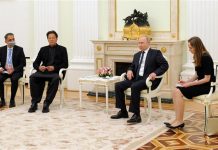Web Desk
Pakistan has received $2.75 billion from the International Monetary Fund (IMF) under its new allocations for member countries to fight against Covid-19 challenges, the central bank reported on Tuesday.
The Washington-based global lender released the funds for Islamabad under its historic funding of $650 billion for the developing and developed member countries.
The new allocations are aimed at elevating the member countries’ foreign exchange reserves to enhance their capacity to make international payments for imports and foreign debt repayments as well as enhance the pace of global economic recovery from the impact of the ongoing health crisis.
The inflows have not only improved Pakistan’s capacity to make international payments but also enhanced its ability to arrest the current depreciation in rupee against the US dollar and other major currencies of the world.
Pakistani currency depreciated to over 10-month low at Rs164.43 against the US dollar in the inter-bank market on Monday.
Following a fresh drop of Rs0.25 on Monday, the rupee has depreciated by 6.39% in the current fiscal year (since July 1) to date and 7.98% since it hit 22-month high of Rs152.27 in May, according to the central bank’s data.
This was the second time that IMF allocated funds for its member countries amid Covid-19 outbreak to cope up with the contagious disease.
In April 2020, it disbursed $1.4 billion to Pakistan.
The board of governors of the IMF had approved a general allocation of Special Drawing Rights (SDRs) equivalent to $650 billion (about SDR 456 billion) on August 2, 2021 to boost global liquidity.
“This is a historic decision – the largest SDR allocation in the history of the IMF and a shot in the arm for the global economy at a time of unprecedented crisis,” IMF Managing Director Kristalina Georgieva said in the statement issued on August 2. “The SDR allocation will benefit all members, address the long-term global need for reserves, build confidence and foster the resilience and stability of the global economy. It will particularly help our most vulnerable countries struggling to cope with the impact of the Covid-19 crisis.”
The Pakistan’s foreign exchange reserves are on the rise for the past two years on the back of strong inflow of workers’ remittances, improvement in export earnings and growth in investment by non-resident Pakistanis in assets in the homeland through the Roshan Digital Accounts (RDAs).
Besides, the country’s reserves are partly maintained through despots from friendly countries such as Saudi Arabia, Qatar and China and through central bank’s short-term borrowing from commercial banks operating in the country.
Almost half of the foreign currency reserves “are filled by long-term borrowing from international financial institutions, friendly countries and short-term borrowing,” Economist Shahid Hasan Siddiqui said the other day.
The central bank said late last month that the imports may continue to remain high during the current fiscal year 2021-22, meaning demand for US dollars may remain high.
The State Bank of Pakistan (SBP) projected the current account deficit to increase to 2-3% of GDP in current fiscal year 2021-22 compared to 10-year low at 0.6% of GDP recorded in the prior fiscal year 2020-21.
It, however, said the deficit at 2-3% is sustainable. This would allow the economy to grow by 4-5% in FY22 compared to 4% in FY21.















